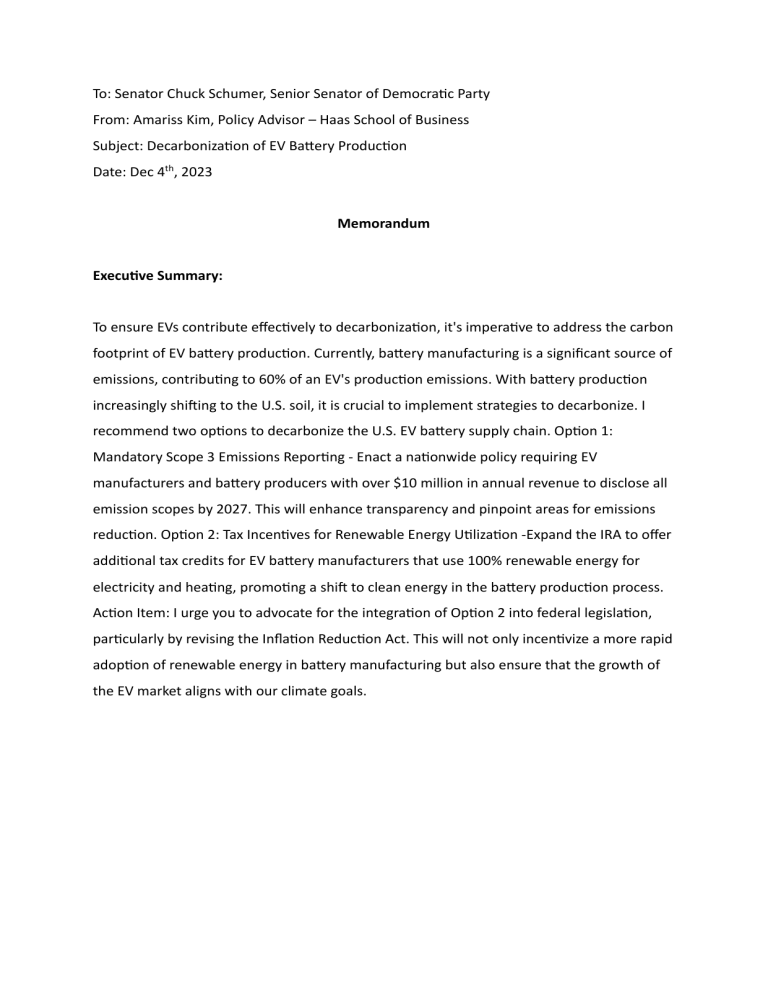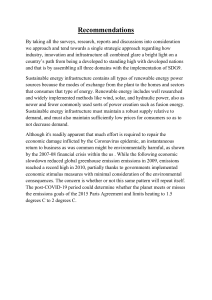
To: Senator Chuck Schumer, Senior Senator of Democra5c Party From: Amariss Kim, Policy Advisor – Haas School of Business Subject: Decarboniza5on of EV BaGery Produc5on Date: Dec 4th, 2023 Memorandum Execu.ve Summary: To ensure EVs contribute effec5vely to decarboniza5on, it's impera5ve to address the carbon footprint of EV baGery produc5on. Currently, baGery manufacturing is a significant source of emissions, contribu5ng to 60% of an EV's produc5on emissions. With baGery produc5on increasingly shiUing to the U.S. soil, it is crucial to implement strategies to decarbonize. I recommend two op5ons to decarbonize the U.S. EV baGery supply chain. Op5on 1: Mandatory Scope 3 Emissions Repor5ng - Enact a na5onwide policy requiring EV manufacturers and baGery producers with over $10 million in annual revenue to disclose all emission scopes by 2027. This will enhance transparency and pinpoint areas for emissions reduc5on. Op5on 2: Tax Incen5ves for Renewable Energy U5liza5on -Expand the IRA to offer addi5onal tax credits for EV baGery manufacturers that use 100% renewable energy for electricity and hea5ng, promo5ng a shiU to clean energy in the baGery produc5on process. Ac5on Item: I urge you to advocate for the integra5on of Op5on 2 into federal legisla5on, par5cularly by revising the Infla5on Reduc5on Act. This will not only incen5vize a more rapid adop5on of renewable energy in baGery manufacturing but also ensure that the growth of the EV market aligns with our climate goals. The Problem: With the support of policies and consumer trends, EV adop5on is accelera5ng. However, while total lifecycle emissions of EV is lower than that of ICEV, EV manufacturing emits more carbon than tradi5onal ICEVs.1 60% of EV produc5on emission comes from baGeries,2 and due to the IRA, significant por5on of EV baGery manufacturing is onshoring in the US.3 While emissions from the shipment of baGeries from Asia has been reduced due to onshoring, to make the EV transi5on a truly an effec5ve path to decarboniza5on, EV baGery manufacturing should be significantly more carbon efficient. Criteria: The strategy op5ons examined in this memo will be measured on their ability to effec5vely, and quickly accelerate decarboniza5on measures of US EV baGery manufacturing. Recommenda5on: As OEMs and baGery players are being rewarded by incen5ves such as the IRA to expand, they must also make effort to decarbonize their embedded emissions in the EV supply chain, especially baGery manufacturing. McKinsey iden5fied four major decarboniza5on levers in baGery manufacturing: increased share of recycled raw materials, electrifica5on of produc5on & logis5cs, low-emission electricity, and low-emission hea5ng. Among these levers, McKinsey stated that energy sources used is one of the biggest factors of emissions. Poten5al policies that can ins5gate ac5on in these areas are: mandatory scope 3 repor5ng of EV supply chain and tax incen5ves for 24/7 renewable energy supply (such as 100% renewable powered standalone baGery storage, renewableenergy powered heat baGery for industrial heat). Op5on 1: Mandatory scope 3 repor5ng of EV supply chain SB 253 requires US companies with annual revenues exceeding $1 billion and doing business in California to disclose their Scope 1, 2, and 3 emissions.4 Similar policy should be adopted na5on-wide, targe5ng automo5ve supply chain – especially EV baGeries. While baGery produc5on is integrated in some OEMs such as Tesla, other automo5ve companies outsource EV baGery produc5on to smaller companies. I suggest the new policy mandate OEMs and EV baGery manufacturers over $10 million annual revenue to disclose scope 1, 2, and 3 by 2027.5 This will provide greater visibility into where emissions is generated in the EV supply chain, and help iden5fy opportuni5es for emissions reduc5on. However, while this policy effec5vely provides visibility with low financial burden, it may not be adequate enough to accelerate decarboniza5on of EV baGery produc5on as it does not incen5vize OEMs and EV baGery manufacturers to take ac5on upon reduc5on. Op5on 2: Tax incen5ves for 24/7 renewable energy supply in EV baGery produc5on The Infla5on Reduc5on Act’s Sec5on 13502 “Advanced Manufacturing Produc5on Credit” provides produc5on credits for baGery cells & modules made in the US ($35 per kWh for baGery cell, $10 for baGery module, $45 for baGery module that doesn’t use baGery cell).6 NREL’s Modified Accelerated Cost Recovery System (MACRS – for business) states that if the baGery system is charged by renewable energy system more than 50% of the 5me on an annual basis, the baGery will qualify for the 5-year MACRS schedule, equal to ~27% reduc5on in capital costs. BaGery systems charged by a renewable energy system 100% of the 5me are eligible for the ITC (investment tax credit).7 While financial incen5ve for both produc5on and usage of renewable energy-powered baGeries are in place, the financial incen5ve is not enough to scale the usage fast enough. As iden5fied earlier, for EV baGery produc5on to be decarbonized, main levers are decarbonizing electricity and heat; addi5onal tax credit should be provided to baGery plants adop5ng renewable energypowered electricity or heat baGeries to enable transi5on to 24/7 renewable energy. Sugges5on: I suggest the US government provide tax incen5ves for EV baGery supply chains to adopt standalone energy storage measures such as heat baGeries powered 100% by renewable energy. This will immediately help accelerate decarboniza5on of EV supply chain by allowing 24/7 renewable energy in the energy intensive baGery supply chain, which takes up to 60% of embedded EV emissions. For the source of funding for this incen5ve, I suggest the government revise the IRA to include this measure to not only accelerate EV adop5on, but to reduce the embedded emissions of EV. References 1. Oguz, Selin. “Life Cycle Emissions: EVS vs. Combustion Engine Vehicles.” Visual Capitalist, 10 Oct. 2023, www.visualcapitalist.com/life-cycle-emissions-evs-vscombustion-engine-vehicles/. 2. Linder, Martin, et al. “The Race to Decarbonize Electric-Vehicle Batteries.” McKinsey & Company, McKinsey & Company, 23 Feb. 2023, www.mckinsey.com/industries/automotive-and-assembly/our-insights/the-race-todecarbonize-electric-vehicle-batteries. 3. Majkut, Joseph, et al. “Onshoring and Friend-Shoring in U.S. EV Supply Chains: What Are the Boundaries?” CSIS, 5 Apr. 2023, www.csis.org/analysis/onshoring-and-friendshoring-us-ev-supply-chains-what-are-boundaries. 4. Rothman, Rick R, et al. “California Requires Companies to Disclose Climate Change Risks, GHG Emissions.” Morgan Lewis, 10 Oct. 2023, www.morganlewis.com/pubs/2023/10/california-requires-companies-to-discloseclimate-change-risks-ghg-emissions. 5. “Top EV Batteries Manufacturers and Companies in the USA.” Thomasnet® - Product Sourcing and Supplier Discovery Platform - Find North American Manufacturers, Suppliers and Industrial Companies, 12 Sept. 2023, www.thomasnet.com/articles/top-suppliers/ev-battery-manufacturers-companies/. 6. IEA. “Inflation Reduction Act 2022: SEC. 13502 Advanced Manufacturing Production Credit – Policies.” IEA, 24 May 2023, www.iea.org/policies/16282-inflationreduction-act-2022-sec-13502-advanced-manufacturing-production-credit. 7. “Cost Recovery for Qualified Clean Energy Facilities, Property and Technology.” Internal Revenue Service, www.irs.gov/credits-deductions/cost-recovery-forqualified-clean-energy-facilities-property-and-technology. Accessed 13 Nov. 2023. Supplementary note Figure 1. Typical upstream baGery electric vehicle emissions Figure 2. Emission intensi5es, kg CO2e/kWh Figure 3. Greenhouse gas emissions by produc5on step, kg CO2e/kWh



